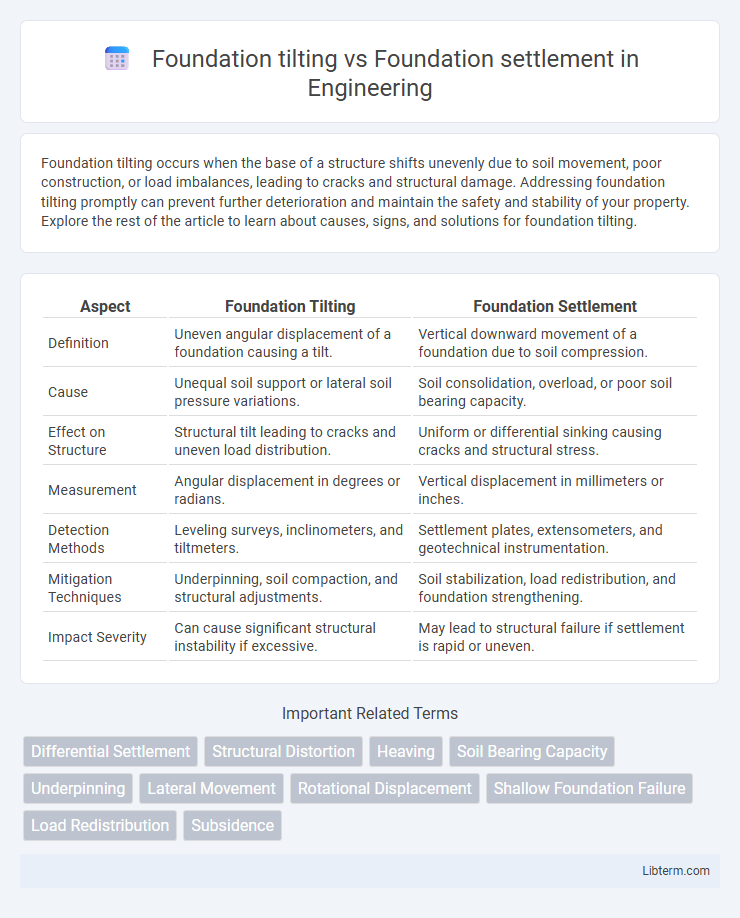Foundation tilting occurs when the base of a structure shifts unevenly due to soil movement, poor construction, or load imbalances, leading to cracks and structural damage. Addressing foundation tilting promptly can prevent further deterioration and maintain the safety and stability of your property. Explore the rest of the article to learn about causes, signs, and solutions for foundation tilting.
Table of Comparison
| Aspect | Foundation Tilting | Foundation Settlement |
|---|---|---|
| Definition | Uneven angular displacement of a foundation causing a tilt. | Vertical downward movement of a foundation due to soil compression. |
| Cause | Unequal soil support or lateral soil pressure variations. | Soil consolidation, overload, or poor soil bearing capacity. |
| Effect on Structure | Structural tilt leading to cracks and uneven load distribution. | Uniform or differential sinking causing cracks and structural stress. |
| Measurement | Angular displacement in degrees or radians. | Vertical displacement in millimeters or inches. |
| Detection Methods | Leveling surveys, inclinometers, and tiltmeters. | Settlement plates, extensometers, and geotechnical instrumentation. |
| Mitigation Techniques | Underpinning, soil compaction, and structural adjustments. | Soil stabilization, load redistribution, and foundation strengthening. |
| Impact Severity | Can cause significant structural instability if excessive. | May lead to structural failure if settlement is rapid or uneven. |
Introduction to Foundation Issues
Foundation tilting occurs when a building's base angles away from its original vertical position due to uneven soil pressure or shifting ground. Foundation settlement involves the gradual sinking of the foundation into the soil, often caused by soil compaction, moisture changes, or poor construction practices. Both issues can compromise structural integrity, necessitating thorough assessment and remediation to prevent severe damage.
Defining Foundation Tilting
Foundation tilting refers to the lateral displacement or angular deviation of a building's foundation from its original position, often caused by uneven soil pressure or load imbalances. This phenomenon contrasts with foundation settlement, which involves vertical downward movement of the foundation due to soil compression or loss of bearing capacity. Detecting foundation tilting is critical for structural integrity, as it can lead to progressive damage and uneven stress distribution within the building framework.
Understanding Foundation Settlement
Foundation settlement occurs when the soil beneath a structure compresses unevenly, causing parts of the foundation to sink at different rates. This uneven compression results in structural damage such as cracks in walls, doors that no longer close properly, and uneven floors. Understanding foundation settlement is crucial for early detection and remediation to maintain building safety and prevent costly repairs.
Key Differences Between Tilting and Settlement
Foundation tilting refers to the angular displacement of a structure's base, causing one side to be higher or lower than the other, while foundation settlement is the vertical downward movement of the entire foundation or parts of it. Tilting often results from uneven soil compaction or differential loading, whereas settlement typically arises from soil consolidation or bearing capacity failure. Understanding these differences is crucial for diagnosing structural damage and implementing appropriate remediation techniques.
Common Causes of Foundation Tilting
Foundation tilting primarily results from uneven soil compaction, poor site drainage, or incorrect design load distribution, causing one side of the structure to sink more than the other. Common causes include expansive clay soils that swell and shrink with moisture content changes, differential settlement where parts of the foundation settle at varying rates, and construction errors such as inadequate footing size or depth. Understanding these factors helps in diagnosing structural tilt versus uniform foundation settlement, which typically occurs uniformly across the entire foundation.
Typical Causes of Foundation Settlement
Foundation settlement typically occurs due to soil consolidation, where the weight of the structure compresses underlying soil layers, causing downward movement. Other common causes include poor soil compaction during construction, changes in the moisture content of expansive clay soils, and inadequate drainage leading to soil erosion or shrinkage. Unlike foundation tilting, settlement primarily involves vertical displacement without significant angular distortion.
Signs of Tilting vs Settlement in Buildings
Signs of foundation tilting include visible slanting of walls or columns, doors and windows that do not close properly due to uneven frames, and noticeable lean in the structure often caused by uneven soil pressure. In contrast, foundation settlement presents as uniform or localized vertical sinking, leading to cracks in walls, especially near corners, and misaligned floors or steps without a significant tilt. Both conditions require prompt assessment, but tilting often indicates lateral soil movement, whereas settlement is primarily a vertical downward shift.
Risks and Consequences of Each Issue
Foundation tilting poses significant risks including uneven load distribution that can lead to structural instability and increased stress on walls, potentially causing cracks or collapse. Foundation settlement often results in differential sinking of the structure, leading to uneven floors, misaligned doors, and compromised structural integrity, which might require costly repairs or underpinning. Both issues can accelerate deterioration, reduce property value, and pose safety hazards if not addressed promptly with professional assessment and remediation.
Inspection and Diagnosis Methods
Foundation tilting typically involves angular displacement detectable through precise leveling instruments and inclinometers, while foundation settlement is characterized by vertical downward movement measured using settlement plates and laser scanning. Inspection methods for tilting include visual assessments for cracking patterns and electronic tilt sensors, whereas settlement diagnosis often employs soil testing, ground-penetrating radar, and borehole extensometers to evaluate subsurface conditions. Accurate diagnosis requires combining surface monitoring data with geotechnical analysis to distinguish between differential settlement and uniform tilting effects.
Repair Solutions for Tilting and Settlement
Foundation tilting and settlement both require precise repair solutions to restore structural integrity and prevent further damage. Tilt correction often involves underpinning techniques such as helical piers or push piers to stabilize and realign the foundation, while settlement repairs typically use slab jacking or mudjacking to lift sunken areas and fill voids beneath the foundation. Effective repair solutions depend on thorough soil analysis and customized engineering plans to ensure long-term stability and prevent recurrence.
Foundation tilting Infographic

 libterm.com
libterm.com